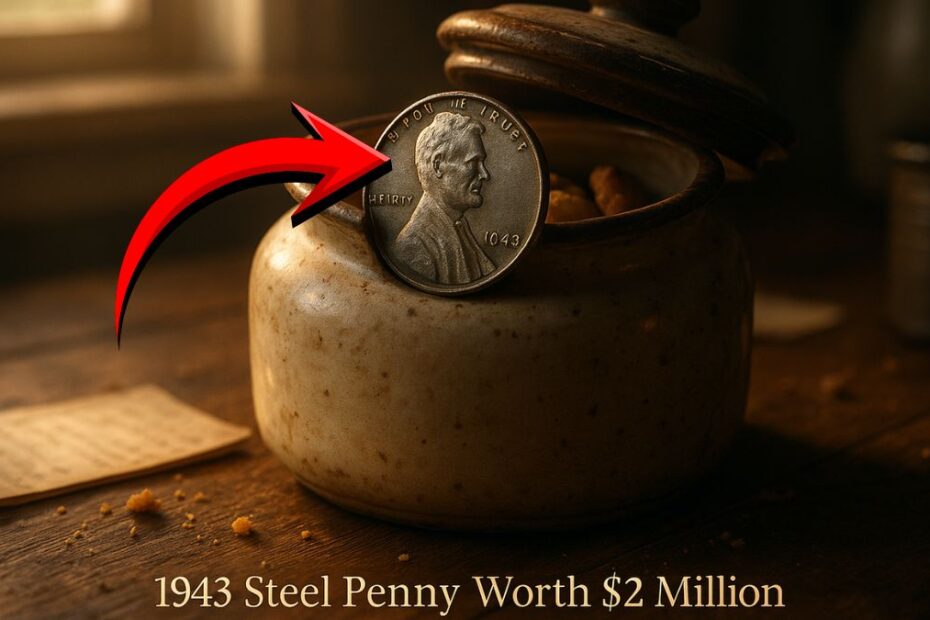When an otherwise ordinary coin is found in a cookie jar and later linked to one of the most sought-after US errors, both collectors and casual savers perk up.
The story of the 1943 penny found stashed away and now worth millions underscores the allure of numismatics.
In this article we explore every detail – the coin’s background, discovery, significance, valuation, and how you might hold a hidden treasure in your change jar.
Background: Wartime Penny Production & The Error
During United States Mint operations in 1943, the US faced copper shortages due to World War II demands. As a result, the famous 1943 Steel Cent was produced: made of zinc-coated steel instead of the usual bronze (95 % copper) composition.
However, in rare instances, bronze planchets (the blanks normally used for copper cents) became trapped in the feed system and a handful of 1943 pennies were struck on bronze rather than steel. These are now the legendary error coins.
Key aspects of this error:
- The standard 1943 cent (steel) weighs approximately 2.702 g and is magnetic (because of the steel).
- A genuine 1943 bronze cent weighs about 3.11 g and will not stick to a magnet.
- The number of known genuine bronze 1943 cents is extremely limited (estimates range from fewer than 20 to about 40 worldwide).
The Discovery in the Cookie Jar
The well-known story involves a young high-school student in Massachusetts, Don Lutes Jr., who in 1947 found what appeared to be the normal steel-toned 1943 penny in his cafeteria change—but upon inspection it looked copper coloured. He kept the coin, later learned its potential rarity, and held onto it for decades.
Though some versions of the story say “cookie jar”, most reporting says he found it in his lunch change. Nonetheless the principle remains: a casual coin find turned into a major error-coin legend.
Why It’s So Valuable
The rarity, the dramatic wartime context, the dramatic visual difference from standard cents and the mystique all contribute to the value of these coins. Highlights include:
- A 1943 bronze cent sold for $1.7 million in 2010.
- More recently, one estimate puts such a coin’s value at $2 million or more in today’s market.
- The mythic status of the coin draws huge interest from serious numismatists.
Key Facts
| Detail | Information |
|---|---|
| Year of coin | 1943 |
| Standard composition | Zinc-coated steel |
| Error coin composition | Bronze (95 % copper) |
| Standard weight | ~2.702 g |
| Error coin weight | ~3.11 g |
| Magnet test | Standard steel coin sticks; error coin does not |
| Estimated number of error coins | Fewer than ~20–40 confirmed |
| Record sale | ~$1.7 million (2010) |
| Possible market value today | Up to ~$2 million+ |
Authentication & Condition Considerations
When evaluating such a coin, collectors focus on:
- Material test: A genuine bronze 1943 principal is non-magnetic. A steel coin will attract a magnet.
- Weight: Being heavier (around 3.11 g) is an indicator of the bronze planchet.
- Strike quality: Because the bronze blanks were struck under steel-coin settings, some error pieces show sharper detail.
- Grading/Condition: Coins graded high (MS-60+) naturally command far higher prices.
- Provenance: A documented find (e.g., the Massachusetts cafeteria story) can boost value.
- Counterfeiting risk: Because of high value, many fake “copper-plated steel” 1943 cents exist. Proper certification (e.g., by Professional Coin Grading Service or Numismatic Guaranty Corporation) is essential.
The Market: What Are Collectors Paying?
While the “$2 million” headline grabs attention, actual realised prices vary depending on grade, provenance, mint mark and authenticity. For example:
- In 2019, a coin found in 1947 sold for $204,000 at auction.
- Some published estimates suggest that by 2050 the value of the rare 1943 bronze penny could “exceed $2 million.”
Thus while the top tier examples (graded superbly, with excellent provenance) might approach or exceed the multi-million mark, many error coins trade in the hundreds of thousands range until a “perfect” specimen hits the market.
Why the “Cookie Jar” Angle Matters
The narrative of discovering a rare coin in a mundane jar or change tin resonates: it suggests that any of us might stumble on a major find. It underscores the importance of checking forgotten jars, old coin collections, childhood piggy banks. For collectors and hobbyists, it’s a reminder that every coin counts and that “common” change might hide extraordinary value.
The story of the 1943 penny found in a jar-like container that could now be worth around $2 million is more than an anecdote—it is a case study in how low-value items can become highly prized through circumstances of minting error, wartime necessity, rarity and market fascination.
For anyone holding an old change jar, the lesson is clear: examine what you have, know what to look for (magnet test, weight, mintmarks), and consider reaching out to a reputable numismatist or grading service. In the world of coin collecting, that humble cent may be far more than a penny.
FAQs
1. How can I tell if my 1943 penny is the rare bronze error rather than the common steel version?
You can test using a magnet (bronze will not stick), weigh the coin (error is ~3.11 g vs ~2.702 g for steel) and inspect finish—sharp strike and reddish colour may signal the bronze. Still, professional authentication is highly recommended.
2. Are there many of these 1943 bronze error pennies known?
No. Estimates suggest fewer than 20 to around 40 genuine examples exist, making them extremely rare and sought after.
3. What might affect the value of one of these pennies if found today?
Value depends on condition/grade, provenance, mint mark (Philadelphia, Denver, San Francisco), confirmation of bronze composition, and market demand at the time of sale. Even among genuine errors, condition and documentation make enormous difference.
